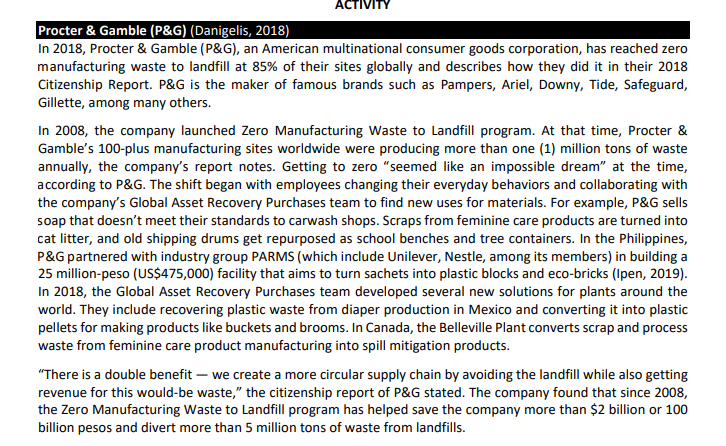1. Identify the organizational driver/s that help P&G recognize the need for its environmental initiative. 2. Using the case facts, explain the pillar/s of sustainability reflected on the given scenario. 3. Decide and justify if P&G's efforts to minimize its manufacturing waste is already enough, given its massive operations and global presence. Cite specific objectives/stages of Environmental Management System (EMS) where further improvements can be applied by the company. 4. Based on the ISO 14001 framework of EMS, suggest other operational areas of P&G where sustainability and environmental management can be integrated.
1. Identify the organizational driver/s that help P&G recognize the need for its environmental initiative. 2. Using the case facts, explain the pillar/s of sustainability reflected on the given scenario. 3. Decide and justify if P&G's efforts to minimize its manufacturing waste is already enough, given its massive operations and global presence. Cite specific objectives/stages of Environmental Management System (EMS) where further improvements can be applied by the company. 4. Based on the ISO 14001 framework of EMS, suggest other operational areas of P&G where sustainability and environmental management can be integrated.
Management, Loose-Leaf Version
13th Edition
ISBN:9781305969308
Author:Richard L. Daft
Publisher:Richard L. Daft
Chapter4: Managing In A Global Environment
Section: Chapter Questions
Problem 1SGB
Related questions
Question

Transcribed Image Text:1. Identify the organizational driver/s that help P&G recognize the need for its environmental initiative.
2. Using the case facts, explain the pillar/s of sustainability reflected on the given scenario.
3. Decide and justify if P&G's efforts to minimize its manufacturing waste is already enough, given its
massive operations and global presence. Cite specific objectives/stages of Environmental
Management System (EMS) where further improvements can be applied by the company.
Based on the ISO 14001 framework of EMS, suggest other operational areas of P&G where
sustainability and environmental management can be integrated.
4.

Transcribed Image Text:ACTIVITY
Procter & Gamble (P&G) (Danigelis, 2018)
In 2018, Procter & Gamble (P&G), an American multinational consumer goods corporation, has reached zero
manufacturing waste to landfill at 85% of their sites globally and describes how they did it in their 2018
Citizenship Report. P&G is the maker of famous brands such as Pampers, Ariel, Downy, Tide, Safeguard,
Gillette, among many others.
In 2008, the company launched Zero Manufacturing Waste to Landfill program. At that time, Procter &
Gamble's 100-plus manufacturing sites worldwide were producing more than one (1) million tons of waste
annually, the company's report notes. Getting to zero "seemed like an impossible dream" at the time,
according to P&G. The shift began with employees changing their everyday behaviors and collaborating with
the company's Global Asset Recovery Purchases team to find new uses for materials. For example, P&G sells
soap that doesn't meet their standards to carwash shops. Scraps from feminine care products are turned into
cat litter, and old shipping drums get repurposed as school benches and tree containers. In the Philippines,
P&G partnered with industry group PARMS (which include Unilever, Nestle, among its members) in building a
25 million-peso (US$475,000) facility that aims to turn sachets into plastic blocks and eco-bricks (Ipen, 2019).
In 2018, the Global Asset Recovery Purchases team developed several new solutions for plants around the
world. They include recovering plastic waste from diaper production in Mexico and converting it into plastic
pellets for making products like buckets and brooms. In Canada, the Belleville Plant converts scrap and process
waste from feminine care product manufacturing into spill mitigation products.
"There is a double benefit – we create a more circular supply chain by avoiding the landfill while also getting
revenue for this would-be waste," the citizenship report of P&G stated. The company found that since 2008,
the Zero Manufacturing Waste to Landfill program has helped save the company more than $2 billion or 100
billion pesos and divert more than 5 million tons of waste from landfills.
Expert Solution
This question has been solved!
Explore an expertly crafted, step-by-step solution for a thorough understanding of key concepts.
Step by step
Solved in 4 steps

Recommended textbooks for you

Management, Loose-Leaf Version
Management
ISBN:
9781305969308
Author:
Richard L. Daft
Publisher:
South-Western College Pub

Purchasing and Supply Chain Management
Operations Management
ISBN:
9781285869681
Author:
Robert M. Monczka, Robert B. Handfield, Larry C. Giunipero, James L. Patterson
Publisher:
Cengage Learning


Management, Loose-Leaf Version
Management
ISBN:
9781305969308
Author:
Richard L. Daft
Publisher:
South-Western College Pub

Purchasing and Supply Chain Management
Operations Management
ISBN:
9781285869681
Author:
Robert M. Monczka, Robert B. Handfield, Larry C. Giunipero, James L. Patterson
Publisher:
Cengage Learning
